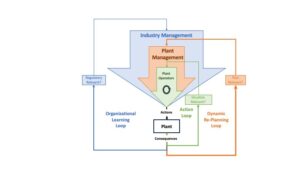
I am still struggling to find the right way to represent the multiple layers of constraint that shape the dynamics of organizations. The image above is framed in terms of a nuclear power plant. As with previous depictions, I include three layers of constraint - recognizing that there may be other layers within layers. However, I think these three layers represent important distinctions that are common across many different organizations.
In this representation - the intention is to emphasize that the layers are nested - such that outer layers set the context or the degrees of freedom for operations at inner layers. Each layer is monitoring operator actions and plant performance - but they are filtering the information to reflect different spheres of action, different degrees of granularity, and different time spans.
At the Industry Management level the focus is on standards associated with regulation, investment, and training. At the Plant Management level the focus is on anticipating events, planning, and supervision. At the Operator level, the focus is on operating, monitoring, and maintaining the equipment.
A key aspect of the coupling across the layers is the degrees of constraint. That is, how loosely or tightly the inner loops are constrained by outer loops. The stability or success of an organization will be a function of finding the right balance of constraint relative to the demands of the work environment (e.g., the pace of change, the degree of complexity/uncertainty). The balance is reflected in attributes such as subsidiarity and trust - which describe whether organizations give more or less discretion (degrees of freedom, decision authority) to inner layers.
A general principle is that when the pace of change or the degree of uncertainty is high, organizations that give more discretion/flexibility to people in the inner layers to directly adapt to situations will be more stable. This is largely due to the longer time constants required for sensemaking at the outer layers. In other words, when events on the ground are rapidly changing in surprising ways, there is no time to wait for direction from upper levels of management. The shifting of military organizations such as the US Marines toward more Mission Command styles of leadership is motivated by a desire to be more effective in a highly dynamic, uncertain domain.
On the other hand, when the work domains are relatively stable, the broader perspective and longer integration periods (i.e., broader experience) of outer layers are less likely to lead the organization to over-react to transient changes (e.g., chase fads). Thus, more top-down control or regulation leads to stable, more efficient performance. For example, commercial aviation and nuclear power domains typically benefit from more top-down regulation and constraint that reflect extensive experience in relatively stable domains of operation.
It is important to recognize that the effectiveness of a polycentric control system (or any control system) can only be judged relative to the functional demands of specific work contexts. So, be skeptical of any models that propose to set the 'ideal' or 'optimal' general recipe for success. Solutions that may have been well tuned to the past, may become unstable when the demands of the work domains change.
